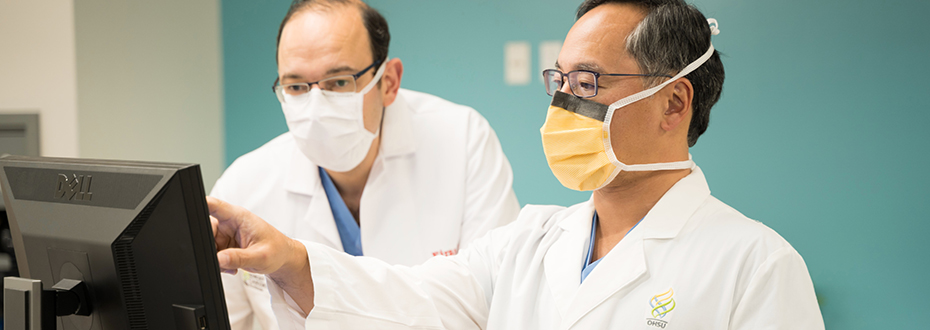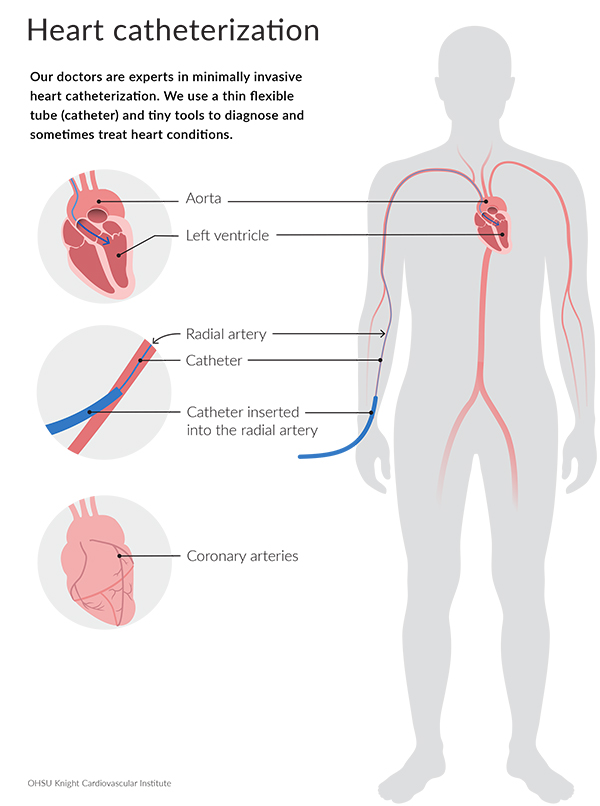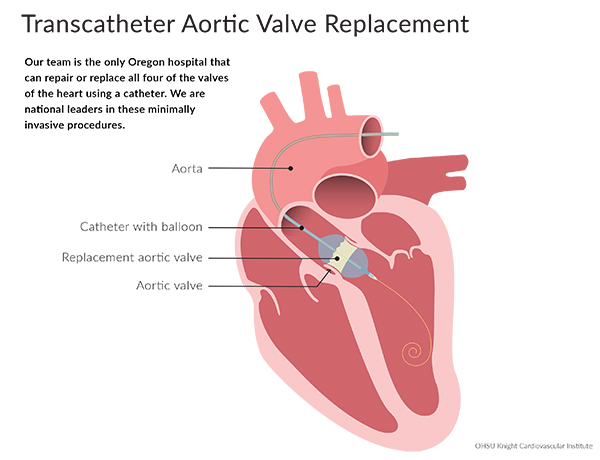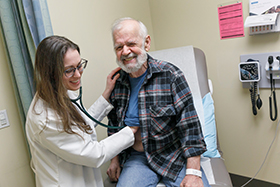Heart Valve Disease Diagnosis and Treatment

The many specialists in our Complex Heart Valve Program combine their expertise to care for each patient. We also offer the widest array of treatment options in Oregon, including some that are available only at OHSU.
You’ll find:
- Providers with deep experience treating patients with high-risk and complex conditions.
- Advanced imaging for precise diagnosis and treatment.
- The latest treatment options, including some that we helped pioneer.
- Access to next-generation therapies through clinical trials.
Complete care
Patients with heart valve disease can have complicated needs. That’s why at OHSU, your care team will include a range of specialists and a coordinator to guide your treatment. Your providers will meet once a week to review your imaging and details of your treatment.
We also understand that while heart valve disease cannot be cured, treatment can ease symptoms and improve your quality of life. Our goal is to give you the best outcomes possible so you can do the things you enjoy.
Your team may include:
- A valve coordinator to set appointments and guide you through treatment.
- A heart surgeon who operates on heart valves and arteries.
- A cardiologist, a heart doctor who is an expert in heart disease.
- An interventional cardiologist, an expert in heart imaging the use of catheters (small tubes) to repair or replace heart valves.
- Other experts, such as cardiac anesthesiologists, nurses who specialize in heart care, and intensive care specialists.
Your first visit: You will meet with a heart surgeon, a cardiologist and an interventional cardiologist together. They will work with you to develop your treatment plan.
Diagnosing heart valve disease

We offer the latest tests to pinpoint your valve condition.
Physical exam: Your care team will start with a thorough exam. You will be asked about your medical history and symptoms. Providers might listen for a heart murmur or check for an enlarged heart or fluid in your lungs.
Echocardiogram: This test uses sound waves to produce images of your heart valves in motion. It helps doctors judge the severity of a valve blockage or leakage.
CT or CAT scan: Computed tomography scans combine X-rays to show detailed images of your heart.
Cardiac catheterization: A specialist guides a long, narrow tube (catheter) to your heart through a blood vessel in the arm or leg. We inject dye and use X-rays to get a clear picture of your heart’s blood vessels and how well they are working. We can also measure blood pressure in the heart.
Cardiac MRI: Magnetic resonance imaging uses a magnet and radio waves to produce detailed pictures of the heart’s valves and chambers. This test can show abnormal blood flow through the heart.
Nuclear stress test: This measures how well blood reaches all areas of your heart. We inject radioactive dye to get two sets of images. Then we look at how your blood flows while you are resting and after you exercise.
Heart valve treatments
We offer Oregon’s widest array of treatment options, performed by experts. Some procedures are available in Oregon only at OHSU.
Medication
Medication can ease symptoms in early stages of the disease. Your team may prescribe medications to:
- Lower your blood pressure or cholesterol
- Prevent irregular heartbeat
- Help your body get rid of excess fluid
If damaged heart valves make it harder for your heart to pump blood, you may need treatment to repair or replace them.
Heart valve repair and replacement
Your care team will discuss the best option for you.
Repair: This option preserves heart tissue. We can:
- Reshape a valve
- Seal holes in a valve flap
- Separate fused valve flaps
- Insert clips or other devices to improve how valves work
Replacement: Some valves are too damaged to repair. We may replace valves with:
- Mechanical valve: These are made of carbon or metal, and are designed to last for life. They increase the risk of blood clots, though, so patients need to take blood thinners for life.
- Biological valve: These are made of human, cow or pig tissue. They last 10 to 20 years and then need to be replaced. Patients do not need to take blood thinners.

Surgical and minimally invasive options
Open heart surgery: Surgeons cut through the breast bone to reach your heart. Once your heart is exposed, a machine takes over heart function and your heart is stopped so it’s still. Your surgeon repairs or replaces valves.
If you need bypass surgery to treat coronary heart disease, your doctors may repair or replace damaged valves at the same time.
Minimally invasive surgery: Surgeons use smaller openings, special tools and cameras to reach the heart valves. Benefits include:
- Less pain and discomfort
- Lower risk of infection
- Shorter recovery times
Transcatheter options: Transcatheter means the procedure is done through a catheter — a thin, flexible tube.
In these procedures, an interventional cardiologist and a heart surgeon work together. They use small openings and real-time imaging to guide the catheter through a blood vessel to your heart. Then they use the catheter to deliver and implant repair devices or replacement valves.
OHSU is the only Oregon hospital that can use this approach to repair or replace any heart valve. Our doctors are national leaders in these procedures. Our patients also have access to the newest devices through clinical trials.
Aortic valve treatment
If you have a narrowed or leaking aortic valve, we will work with you to choose the best option.
Options include:
- Open-heart or minimally invasive surgery
- Transcatheter aortic valve replacement (TAVR): A doctor inserts a catheter with a replacement valve into a blood vessel, usually in your upper leg, and guides it to your aortic valve. They use advanced imaging to guide the artificial valve into place.

Mitral valve treatment
We offer more treatment options than any center in Oregon for mitral valve disease. OHSU was the first hospital in Oregon and only the third in the U.S. to replace a mitral valve without open-heart surgery.
Options include:
Surgical mitral valve repair: Surgeons reach the valve through a small opening in the chest. This allows for faster recovery than with open-heart surgery.
Transcatheter mitral valve repair: Surgeons use a catheter to put a clip on leaky valve flaps. This helps them close more tightly. OHSU is testing new mitral valve repair devices, offering patients access to the latest technology.
Transcatheter mitral valve replacement: If you are too high-risk for traditional surgery, we will look at transcatheter options to replace the valve. These are available through clinical trials.
Tricuspid valve treatment
Options include:
- Open-heart or minimally invasive surgery
- Transcatheter options, available through clinical trials, to repair or replace the tricuspid valve. OHSU is the only center in Oregon to offer these.
Pulmonary valve treatment
Many types of pulmonary valve disease are caused by heart defects that develop before birth. OHSU was the first medical center in Oregon to place a pulmonary valve without open-heart surgery. Our doctors are the most experienced in Oregon with this procedure.
Treatment options include:
- Open-heart or minimally invasive surgery
- Transcatheter pulmonary valve replacement (TPVR): This is an option for children and adults who have already had surgery to fix a congenital heart defect. We use a catheter to replace a narrow or leaky pulmonary valve.
Additional services
Cardiac rehabilitation: We offer a doctor-supervised exercise and education program to help you recover from surgery or other procedures.
Palliative care: Our palliative specialists can help you and your family manage anxiety, pain and other issues. The offer services to anyone with a serious illness.
Nutrition services: Our dietitians can help you create a heart-healthy eating plan.
Learn more
- Heart Valve Surgery Goals, American Heart Association
- Options for Heart Valve Replacement, American Heart Association
For patients
Call 503-494-1775 to:
- Request an appointment
- Seek a second opinion
- Ask questions
Locations
Center for Health & Healing Building 1
3303 S. Bond Ave.
Portland, OR 97239
Map and directions
Physicians Pavilion
3270 S.W. Pavilion Loop
Portland, OR 97239
Map and directions
Refer a patient
- Refer your patient to OHSU.
- Call 503-494-4567 to seek provider-to-provider advice.
Ask the experts
Have a heart care question? Submit it here. Our experts will respond to you within a week.
You can also explore our frequently asked questions. Our heart and vascular team may have already posted an answer to your question.
‘I can do so much more’

After a minimally invasive heart valve repair, Dennis Eggers got back to work on his 8-acre farm in Sweet Home: “I am ... fortunate that OHSU has people with the expertise needed to provide me this care.”